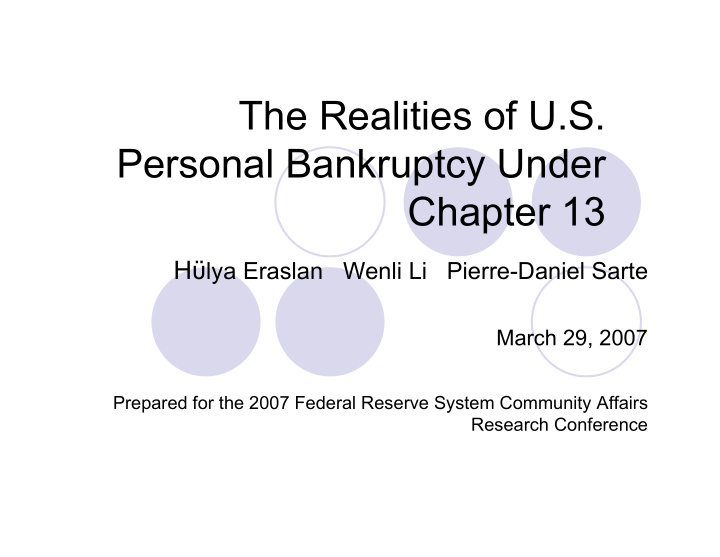



The Realities of U.S. Personal Bankruptcy Under Chapter 13 H ϋ lya Eraslan Wenli Li Pierre-Daniel Sarte March 29, 2007 Prepared for the 2007 Federal Reserve System Community Affairs Research Conference
Introduction and Motivation Figure 1. Annual Bankruptcy Filings as a Percent of Total Households 1.6 1.4 Total Total Filings/ Total Households 1.2 1.0 Chapter 7 0.8 0.6 0.4 Chapter 13 0.2 0.0 91 92 93 94 95 96 97 98 99 00 01 02 03 04 05
Introduction and Motivation In short, the bankruptcy system operates behind a veil of darkness created by the lack of reliable data about its operations. The lack of information about ‘what is going on’ in the bankruptcy system leads to a distrust of its results — a belief by some that creditors, debtors and professionals within the system are all somehow taking advantage of one another and the public at large, and that the system suffers from widespread fraud, abuse and inefficiency. — 1997 National Bankruptcy Commission
Goal: Provide one of the first extensive analyses and some of the first evidence on the performance of Chapter 13 � Construct a unique data set using information gathered from court documents � Construct measures that capture the performance of Chapter 13 bankruptcy � Conduct analysis to identify factors that are important to the actual outcome of Chapter 13 cases
Some Institutional Details � Personal bankruptcy in the U.S. prior to 2005 � Two Chapters: 7 (liquidation) and 13 (reorganization) � Mostly voluntary bankruptcy and chapter choice decisions � Creditors’ legal remedies outside of bankruptcy � Secured: foreclose on the property � Unsecured: collect, garnishing wages, seizing assets � Key features of Chapter 13 personal bankruptcy � Debtors must devote all “disposable” income to the plan � Plan must be between three to five years and cure default on secured debt � Plans subject to changes
Data � Data source: Federal Appellate District and Bankruptcy Courts via PACER � Listing of all parties and participants � Chronology of the dates of case events in the case record and claims registry � Imaged copies of documents filed for specific cases � Data description � Total filings: 965; converted to chapter 7: 61 � As of Jan. 6, 2007 � Terminated: 817; discharged: 379; dismissed: 438 (four converted)
Debtors’ Profiles � Who files for Chapter 13? � Steady job and income, most own homes � Heavily indebted, both secured and unsecured � Some in legal trouble already, many with prior bankruptcy history � What did they file? � Mostly five-year plans (many by necessity) � Promised payment: over half of overall debt, and more than one-third of unsecured debt
Final Outcomes: GRIM � � Less than half succeed under Chapter 13 � 82% confirmed, yet to date 33% discharged � 6% converted to Chapter 7, of the converted 7% fail � Median creditors of all categories receive nothing � Mean: 28 cents on a dollar for total creditors, 17 cents for unsecured, 36 for secured � Median: 13 cents on a dollar for total creditors, 0 for both secured and unsecured � Expensive: 17 percent payments to attorney, 5 percent to trustee
Debtors file Trustee Trustee Shocks to Trustee Debtors Plan Chap. 13 makes confirms debtors’ lets the continue finished, petition, wage the plan payment case or exit case repayment order or ability continue discharged plan decision dismisses realized or submitted the case dismisses it Beginning End of Stage 1 Stage 2 Stage 3 Stage 4 Stage 5 of the the period period
Structural Estimation � Estimation technique � Maximum likelihood to match observed proposed plan length, wage order, confirmation, discharged, and payment rate � Results � Factors important for trustee’s decisions � Wage order: self-employment, attorney experience, job tenure � First confirmation: proposed excess plan length, wage order, attorney experience, total debt-to-asset ratio � Dismissal after confirmation: proposed excess plan length, wage order, shocks to payment ability, pending lawsuit, unsecured debt to total debt � Policy experiments (preliminary) � Policy implication: not very optimistic on the new act
Recommend
More recommend